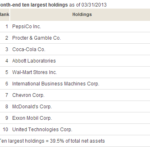With interest rates at record lows, corporate cash balances at record highs, and tax policy visibility as low as it could ever be, corporate spending on buybacks came in 50% higher in 2012 than the average in the preceding decade. The turn towards buybacks is clear; how it will affect total returns isn’t as certain.
Not all buybacks are created equal. Buybacks can be used to:
- Simply cover up stock option compensation. Buybacks that simply displace stock dilution from option-based compensation do little to reward investors. Most buyback policies are instituted for this reason: to reduce the impact of option issuance on total shares outstanding and nothing more.
- Reward shareholders sporadically. Tradition dictates that dividend policies be consistent, but buybacks can be as infrequent and “chunky†without disappointing shareholders. A dividend cut or increase can come with huge turnover in shareholders, but a change to repurchase policies rarely has the same effect.
- Reduce the impact of transactions on continued investments. Buybacks increase an investor’s position in a company without creating new tax liabilities or commissions. Dividends bring capital gains taxes and transaction costs as funds are reinvested.
Buybacks aren’t as visible as dividends, and thus their impact on stock prices isn’t immediately observed by investors. This leads to controversy among investors who feel that buybacks might not be as rewarding to shareholders as continued reinvestment in the business, dividends, or acquisitions.
Studies point to higher returns for companies that repurchase shares, however.
Only Some Buybacks Boost Returns
The most rewarding buybacks are those that are large enough to reduce total shares outstanding. Ford Equity, which provides the model for the BuyBack Acheivers ETF (PKW), discovered that companies that reduced their share counts through repurchases provided above-average returns. Those that repurchased more than 5% of their shares outstanding produced even higher returns. The lesson was simple: if a company buys back more than 5% of its share count, buy!
Companies that repurchased more than 5% of their shares outstanding beat the S&P 500 index in 27 of 28 years, with average excess returns of 13.2% to 2006, according to a Ford Equity release.
Research also showed that this strategy of buying companies who reduce their share count had a few ancillary benefits:
- The strategy produced plenty of positive years even when the broad market posted losses. In the dot com crash of the early 2000s, companies that repurchased more than 5% of their share count posted double digit returns in 2000 and 2001.
- Companies that were active in repurchasing shares had much less volatile stock prices, resulting in lower volatility for the portfolio.
- The strategy resulted in a portfolio with low turnover relative to other strategies, active or passive.
The buyback strategy simply beats the market all the way around.
Follow the Strategy with the Buyback Acheivers ETF
The best part of this strategy just might be how easy it is to follow. The PowerShares Buyback Achiever Portfolio (PKW) invests in companies which have repurchased 5% or more of their total shares outstanding in the previous 12 months. There are no other restrictions; the fund simply buys shares of companies actively repurchasing shares and holds them for one year, rebalancing quarterly and picking new stocks once each year.
The fund’s five-year 45.87% return easily trumps the return of the S&P 500 Index Fund (SPY), which returned only half that, 22.5%, over the last five years despite the fund’s above-average fee of .71% and below-average volatility.
There’s no guarantee that the strategy will continue to outperform, but the logic is there: buybacks reduce share count, increase an investor’s leverage to a business’s operations, and quietly set the stage for faster and more tax efficient compounding. It might might be pretty, but the strategy simply makes sense. Â For a similarly interesting market-beating ETF with sustained performed, also check out the Spin-Off ETF, which also bests the S&P500 handily over various multi-year periods.
Disclosure: No position in any tickers mentioned here.










{ 0 comments… add one now }